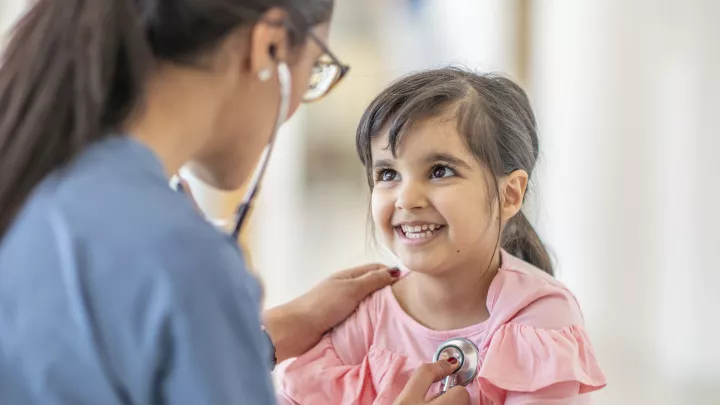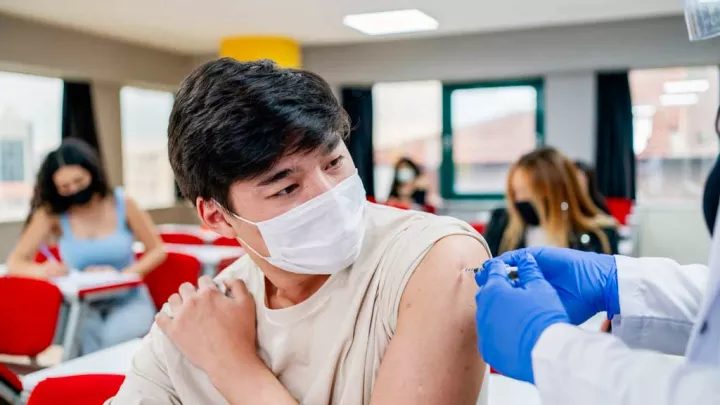Chest CT Scan
Computed tomography (CT) is an imaging test that provides more detail than an X-ray. CT scans, sometimes called CAT scans, use special X-ray machines to take multiple cross-sectional images from different angles. The machine puts together these images to create more comprehensive pictures of the:
- Internal organs
- Bones
- Tissue
- Blood vessels
CT scans show soft tissue and other details not visible on regular X-rays. Doctors can also use CT scans to create 3D images. Sometimes, doctors request a CT with contrast—a special dye—to highlight specific parts of the image.
A chest CT scan takes pictures of your child’s:
- Heart
- Lungs
- Blood vessels
- Airway
- Ribs
- Lymph nodes
Modern CT scanners can take pictures of a beating heart. A cardiac (heart) CT scan shows a detailed view of your child’s heart and blood vessels.
Reasons to do a Chest CT
Doctors may use a chest or cardiac CT scan to diagnose or monitor:
- Congenital heart defects
- Heart or lung tumors
- Airway diseases, like pneumonia, inflammation of bronchi (passageways to the lungs) and pulmonary hypertension
What to Expect During a Chest CT Scan
- Like chest X-rays, chest and heart CT scans are painless and noninvasive. Your child’s doctor will give you instructions to prepare for the CT scan. Although most CT scans can be performed without general anesthesia, some children cannot stay still even for the short time required for the scan. This decision will be made by the anesthesiologists providing care in the imaging center, together with your input.
How to prepare
Depending on the type and reason for the CT, your child may need to:
- Fast: Children getting a CT with contrast or those who will be sedated (to keep them still) need to stop eating or drinking several hours before the test.
- Change into a hospital gown: Some metal objects—like jewelry, eyeglasses, hearing aids, retainers and hairpins—may interfere with the images. The CT technologist tells you if your child needs to remove any clothing or accessories for the test.
- Get an IV: The CT nurse inserts the IV into your child’s hand or arm. Children who receive sedation to keep still during the test will also receive an IV for the sedatives.
What happens during the scan
Your child gets the CT scan in a special room with a CT machine and small table. The CT scanner is shaped like a donut, with a space in the center for the table.
The test process is like other imaging tests:
- The CT technician positions your child lying down on the table. Your child needs to keep still during the test to get a clear image. While children may not like keeping still, the test itself is not painful. The technician may use pillows or straps to help your child stay in the correct position.
- The technician returns to the monitoring booth to perform the test. Your child can speak to the technician through a speaker.
- The table moves through the machine during the test as the machine makes some loud noises. Your child may receive earplugs or headphones to help make the test more comfortable. During the test, the technician may ask older children to hold their breath for a few seconds.
- The test itself is very fast. It takes several seconds to minutes. Depending on how many images or positions the doctor requests, the whole process may take 30 to 60 minutes.
Chest CT Benefits vs. Risks
Doctors consider chest CT scans safe and noninvasive. Since children are more sensitive to radiation, they should only receive chest or cardiac CT scans when there is a clear need and benefit.
Benefits
CT scans supply valuable information to help doctors diagnose and treat your child. If another test cannot provide the necessary detail, the benefits of a chest CT outweigh any risks. Benefits of a chest CT include:
- Painless, noninvasive and accurate: CT scans allow doctors to see inside your child’s body and give accurate, real-time information. Often, CT scans eliminate the need for more invasive procedures like biopsies or surgery. If a biopsy is necessary, doctors can use CT scans as a guide to keep the procedure as minimally invasive as possible.
- Comprehensive images: Chest CT scans give a detailed view of your child’s bones, internal organs, soft tissue and blood vessels, all in one image. This is an advantage over other types of imaging, and this systemic view is helpful for diagnosing many different conditions.
- Better for some children: The CT scan is less sensitive to movement than tests like cardiac MRI. Sometimes this means a CT scan can be performed in a young child without anesthesia. New technology allows examinations to use less radiation and to be performed in just a few seconds which makes the process easier for children.
- Excellent for very small blood vessels: CT scans are often the best choice to image very small blood vessels like the arteries that supply the heart with blood.
Risks
Chest CTs have a few potential risks:
- Exposure to small doses of radiation: CT scans use X-rays, a form of radiation, to take images. The CT scan uses a very low level of radiation, and the radiation does not stay in your child’s body. Currently, a CT scan has approximately the same amount of radiation as your child is exposed to from the environment each year, but that amount has been decreasing rapidly with improvements in equipment.
- Rare allergic reaction to contrast dye: The dye used for CTs with contrast has iodine. Children rarely have allergic reactions to iodine, and when they do, the reactions tend to be mild. The radiology department is prepared to treat allergic reactions if they happen.
- Rare complications from sedation: There is always a risk of complications with general anesthesia or sedation. The technician watches your child closely to detect and quickly treat complications if they occur.
Cardiology Care at Children’s Hospital Los Angeles
At CHLA, your child receives excellent care from world-class experts. Learn more about our pediatric heart programs and services.


